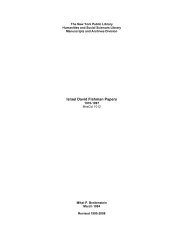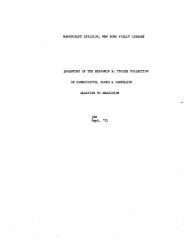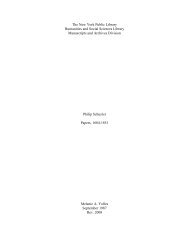pdf available - Multiple Choices
pdf available - Multiple Choices
pdf available - Multiple Choices
You also want an ePaper? Increase the reach of your titles
YUMPU automatically turns print PDFs into web optimized ePapers that Google loves.
LIFE, RECONSTRUCTION, AND CREATIVITY 103<br />
The Jews of the city immersed themselves in<br />
the excitement of the elections for rabbi. This<br />
commotion lasted more than two years. The elections<br />
took place on November 5, 1936. In addition<br />
to three local rabbisR. Pinchas Oselka, R. Leybl<br />
Melamed, and R. Alter Londona number of<br />
other rabbis from central Poland and Galicia also<br />
submitted their candidacy, responding to an advertisement<br />
in the newspapers, published in accordance<br />
with the law. But the "outsiders" had<br />
little chance of being elected, for no one locally<br />
really knew them, and no one was interested in<br />
bringing a fourth rabbi to town.<br />
The main competition was between R. Alter<br />
London and R. Leybl Melamed, both of whom<br />
had enthusiastic supporters. But R. London's<br />
people were livelier and more clever, and saw to<br />
it that the election of R. Alter would be assured.<br />
The community council elections of 1931<br />
were conducted in an expectant atmosphere,<br />
affected by the upcoming rabbinic elections. R.<br />
Leybl's relatives knew, because of the rabbi's age<br />
and failing health, that they had to be prepared<br />
for any sudden "eventuality" and therefore saw<br />
to it that many members of their family and<br />
supporters of Rabbi London would be sitting on<br />
the council.<br />
In these elections, all lines between the<br />
Chasidim and the various shtiblach were blurred,<br />
as were all public and ideological boundaries,<br />
and the candidates for the councilthough they<br />
officially appeared to be representing the synagogueswere<br />
really friends or relatives of the<br />
London family.<br />
Also, the electorate voted for the most part<br />
based on its relationship with the rabbi. For<br />
instance, it was known that a segment of the<br />
Trisker Chasidim, the bastion of R. Melamed,<br />
voted for the Kotsker list of candidates headed by<br />
R. London's nephew, because they were friends<br />
or relatives of the London family. Using this<br />
tactic, they assured themselves of a majority on<br />
the council and the chairmanships. Later on, in<br />
1934, the community council chose the committee<br />
for election of the communal rabbi, whose<br />
absolute majorityand particularly its chairman<br />
and vice-chairmanwere supporters of R. London.<br />
This spoiled all hopes for R. Melamed and on<br />
election day was a deciding factor in the results.<br />
As said, rabbinic elections took place on<br />
November 5, 1936, from 7 a.m. to 9 p.m. Almost<br />
1,000 people voted, and the majority were for R.<br />
Leybl Melamed. But due to a technical trick, the<br />
majority was turned into a minority and it was<br />
decided that R. Alter had received about 20 votes<br />
more than R. Melamed.<br />
R. Alter London was declared the rabbi of the<br />
city, and he served in that position until he was<br />
killed by the Nazis in July 1941. He was one of the<br />
first martyrs in our city.<br />
The Community Council of 1936<br />
On November 3, 1936, two days before the elections<br />
for rabbi, there were elections for the community<br />
council. This time, too, the rabbi's supporters<br />
made sure their people got onto the council, so<br />
there would be a strong faction to support him.<br />
In these elections there were already candidates<br />
on the lists from the shtiblach, known to be<br />
Zionists, who also were elected. In 1936, those<br />
elected were R. Meyer Sandlshteyn, from the<br />
Kotsker Chasidim; R. Avrom Grimatlicht of the<br />
Rizhiner Chasidim; R. Aron-Leybish Lichtmacher<br />
from the Radziner Chasidim; R. Asher<br />
Tannenbaum and R. Nathum Stern from Trisk;<br />
for the synagogue of the Misaskim and the<br />
Chasidim of Stepen: R. Velvl Sheinwald; and two<br />
from the craftsman's guild.<br />
The council continued to carry on its duties<br />
along much the same lines as before. They added<br />
to their agenda a major task, that of creating a<br />
Yavneh Hebrew school for national, religious<br />
education. And with the cooperation of other<br />
public figures, organizing for this school began.<br />
The community gave the refurbished building of<br />
the Talmud Torah for the new school and the<br />
council offices were transferred from this building<br />
to a private house on Teatralna Street, which<br />
was rented bi-annually.<br />
A segment of the extremist religious Jews<br />
caused a furor and objected strenuously to the<br />
Yavneh school. They even brought the Radziner<br />
Rebbe, R. Shloymele Leiner, of blessed memory,<br />
who stayed about two weeks, giving speeches<br />
against the school. He also organized a big demonstration<br />
at the community building. It is impor-







